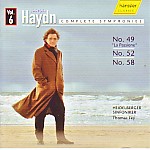Haydn’s 49th and 52nd symphonies rank with the most emotionally tense works of his “Sturm und Drang” period, and you would think that their eruptive moods and jagged rhythms would play directly to Thomas Fey’s strengths. Well, almost. He’s certainly exciting in the allegros of both works, and he characterizes the “limping” (“alla Zoppa”) of Symphony No. 58 particularly well. However, in the dark Adagio that opens “La Passione” his “authentic” approach to string timbre renders the result not so much gaunt as dessicated (or so it sounds in such deeply emotional music), though he has the very good sense to adopt a tempo that keeps the music flowing.
The biggest problem with these performances stems from his decision to use a harpsichord continuo in the tuttis, a practice nowhere supported by the historical evidence, and one that undercuts the music’s modernity and emotional intensity at every turn (and the instrument itself has an unusually twangy timbre). Now this is not the place to go into all of the reasons why this is a bad idea–just listen to the first movement of Symphony No. 52. I simply can’t believe that even if Haydn did want a keyboard instrument, the player sat there and flailed away on the bass line’s repeated eighth-notes like a petulant child having a tantrum. It’s ugly, plain and simple. Rather than outlining the harmony and getting out of the way, the keyboard becomes a most unwelcome solo attraction, precisely the opposite of what a continuo part should be.
So while I admire the intensity that Fey brings to these works, and the high standard of playing by his orchestral forces, these interpretations strike me as slightly misconceived at a very basic level. Other listeners might well disagree, and if so I understand. I can’t knock down the rating too much based solely on this quirky preference of mine, so if you collect this series (as I do), you’ll probably want this disc anyway, continuo or no.
Finally, some readers may recall that I previously reviewed this disc, giving it a 10/10, almost exactly two years ago in 2006. Normally, I don’t revisit reviews without very good reason, but this is one of those cases that I believe is justified. Thanks to the vagaries of Haenssler’s US distribution, I received three Fey discs at once after a long hiatus (including this one, even though it’s technically not a new release). Playing them in sequence at a sitting, I found two to be equally outstanding (the ones containing Symphonies Nos. 70 and 86), but this one struck me in context as a bit less good–primarily for the same reasons that I also noted in my original review, but expand upon here. So I hope that readers won’t object to my taking a fresh look so as to give a more nuanced view of the series as a whole.
































